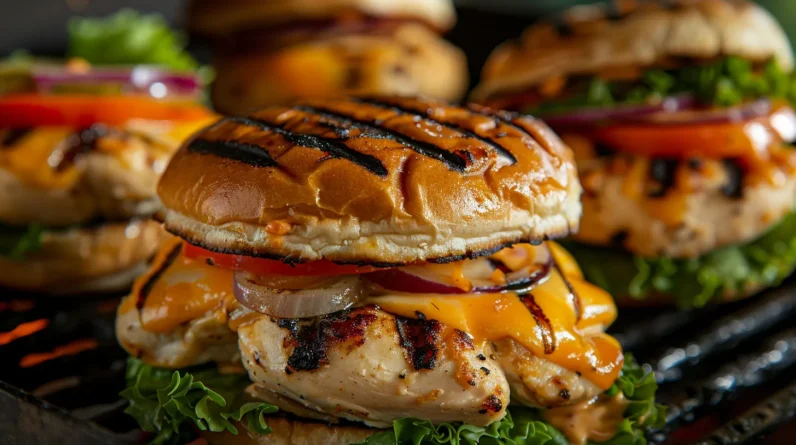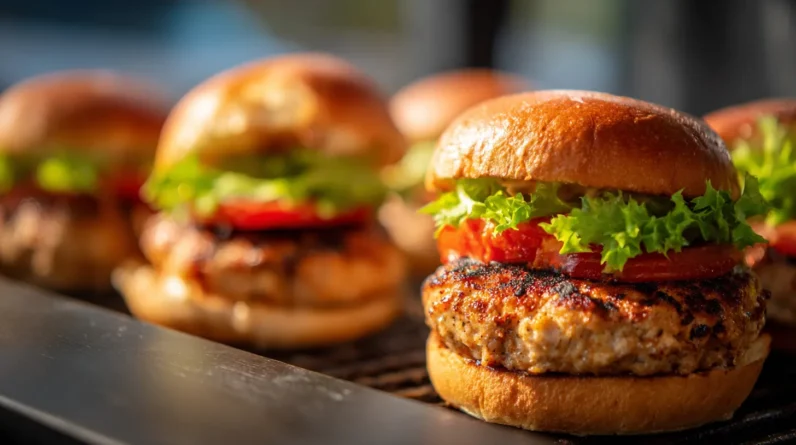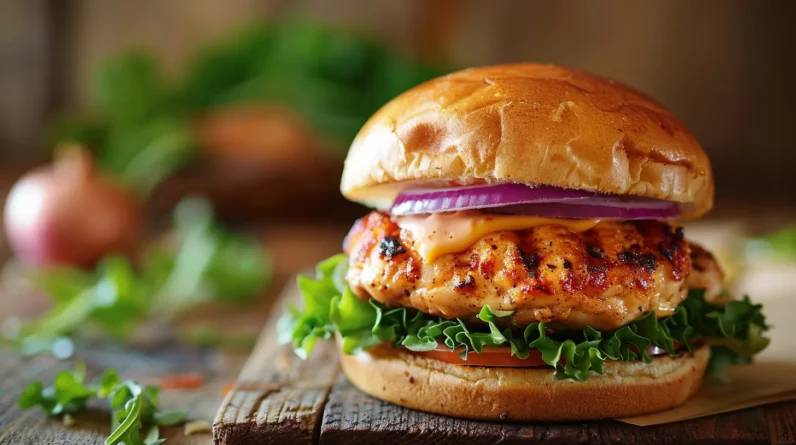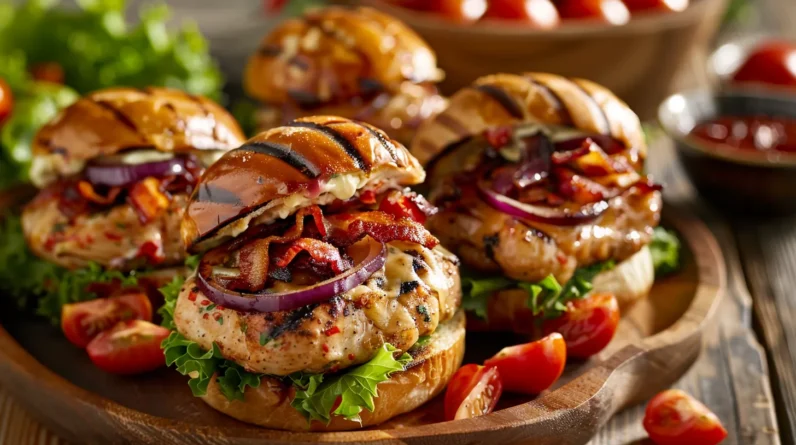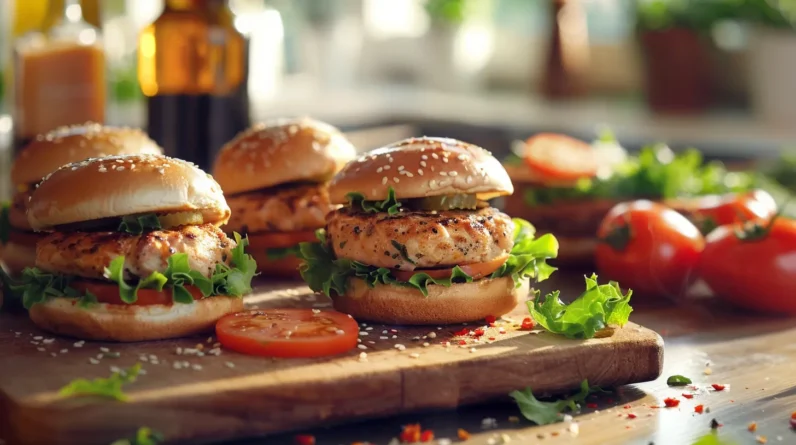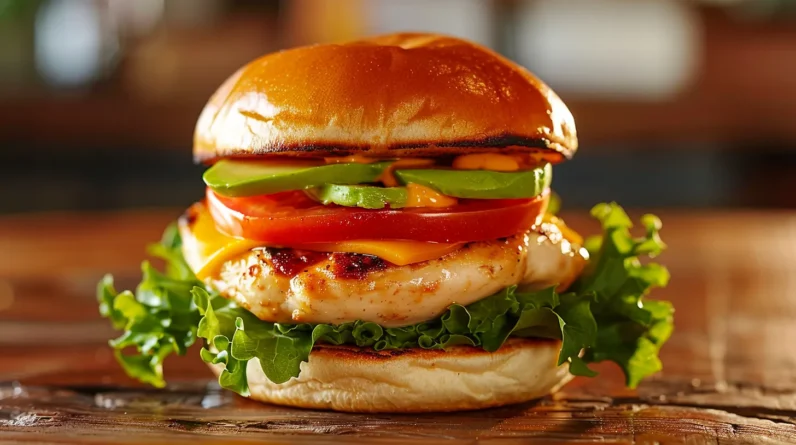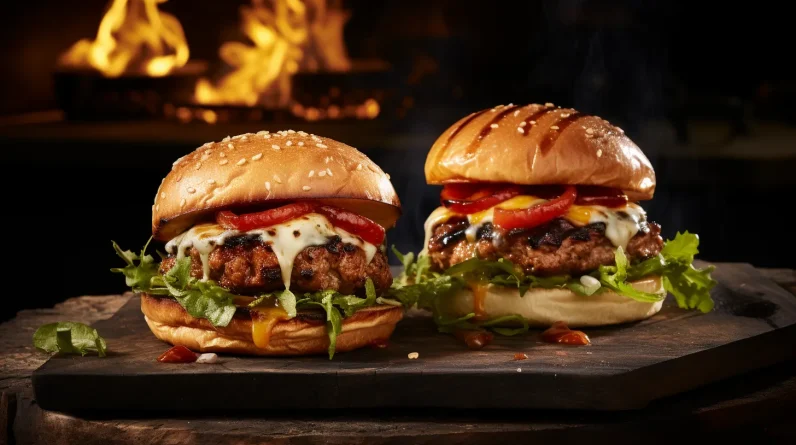
Grilling or pan-frying? The age-old debate continues when it comes to creating the perfect chicken burger. This article delves into the intricacies of both methods, exploring the nuances that contribute to the ultimate culinary experience.
With a focus on precision and analysis, we will examine the techniques and flavors that elevate each cooking method. Whether you seek the smoky char of the grill or the crispy exterior of a pan-fried burger, this article will empower you to make an informed decision in the pursuit of gastronomic freedom.
Key Takeaways
– Grilling and pan-frying are both popular methods for cooking chicken burgers.
– Temperature control and cooking time are important factors to consider when grilling chicken burgers, while cooking times based on patty thickness are crucial for pan-frying.
– Preheating the grill to medium-high heat and cooking over medium heat are recommended for grilling and pan-frying, respectively.
– Experimenting with different bun options and customizing seasonings and marinades can enhance the flavor and overall eating experience of chicken burgers.
The Basics of Grilling Chicken Burgers
When grilling chicken burgers, it is important to understand the basics of temperature control and cooking time. Grilling techniques can vary, but the principles remain the same. The first step is to choose the right chicken patty.
Opt for lean ground chicken or chicken breast patties, as they tend to hold their shape better on the grill. These options also provide a healthier alternative to traditional beef burgers.
Once you have selected the perfect patty, it is crucial to preheat the grill to medium-high heat. This ensures that the chicken burgers cook evenly and develop a delicious charred exterior. It is recommended to oil the grill grates before cooking to prevent sticking.
Temperature control is key to achieving perfectly cooked chicken burgers. Start by searing the patties for about 5 minutes per side, or until they reach an internal temperature of 165°F (74°C). Use a meat thermometer to ensure accurate results. Avoid flipping the burgers too frequently, as this can lead to less even cooking and potential dryness.
Mastering the Art of Pan-Frying Chicken Burgers
To achieve perfectly cooked and flavorful chicken burgers, it is essential to master the art of pan-frying them. Pan-frying chicken burgers can result in a juicy and tender patty with a delicious crispy exterior. The key to successful pan-frying lies in understanding the cooking times for the chicken burgers.
The cooking time for pan-fried chicken burgers depends on the thickness of the patty and the desired level of doneness. On average, it takes about 4-6 minutes per side to cook a 1/2-inch thick chicken burger to perfection. However, thicker patties may require additional cooking time. It is important to cook the chicken burgers over medium heat to ensure even cooking and prevent burning.
When it comes to choosing the right bun for pan-fried chicken burgers, there are various options to consider. A classic hamburger bun works well, providing a soft and sturdy base for the patty. For those looking for a healthier option, whole wheat or multigrain buns can be a great choice. Alternatively, ciabatta or brioche buns add a touch of sophistication and a unique flavor to the chicken burger.
Mastering the art of pan-frying chicken burgers involves understanding the cooking times and selecting the perfect bun to complement the flavors. With practice and experimentation, one can achieve a delicious and satisfying pan-fried chicken burger that rivals any grilled counterpart.
Flavorful Seasonings and Marinades for Grilled Chicken Burgers
For a mouthwatering flavor profile, consider incorporating a variety of flavorful seasonings and marinades into your grilled chicken burgers. Creative marinade combinations can elevate the taste and add complexity to your burgers.
One delicious option is a combination of soy sauce, ginger, garlic, and honey. The soy sauce adds a savory umami flavor, while the ginger and garlic provide a subtle kick. The honey adds a touch of sweetness that balances out the flavors.
Another interesting marinade is made with lemon juice, olive oil, thyme, and crushed red pepper flakes. The citrusy tartness of the lemon juice pairs well with the earthy notes of thyme, and the red pepper flakes add a hint of heat.
Alternatively, you can explore different spice rubs for pan-fried chicken burgers. A classic combination is paprika, garlic powder, onion powder, and black pepper. The paprika adds a smoky flavor, while the garlic and onion powders provide depth. The black pepper adds a slight heat that complements the other seasonings.
Experimenting with different seasonings and marinades allows you to customize your chicken burgers to suit your taste preferences. So go ahead and unleash your culinary creativity, and enjoy the freedom of flavor.
Perfecting the Crispy Exterior of Pan-Fried Chicken Burgers
Achieving a perfectly crispy exterior on pan-fried chicken burgers requires a generous coating of breadcrumbs. The breadcrumbs not only add a delicious crunch, but they also help to create a barrier between the meat and the hot pan, preventing the burger from sticking and ensuring an even, golden brown crust. To achieve the desired texture, it is important to evenly coat the chicken burgers with the breadcrumbs, pressing them firmly onto the surface of the meat.
In addition to using breadcrumbs, the choice of oil for pan frying is crucial in achieving a crispy exterior. Different oils have different smoke points, which determine how hot the oil can get before it starts to smoke and burn. To achieve a golden brown crust without burning the breadcrumbs, it is recommended to use oils with high smoke points such as canola, vegetable, or peanut oil. These oils can withstand the high heat required for pan frying without breaking down or imparting a burnt flavor to the chicken burgers.
Tips and Tricks for Juicy and Tender Chicken Burgers
Regularly basting the chicken burgers with melted butter or marinade, and flipping them at the right time, helps to ensure they remain juicy and tender throughout the cooking process. Basting with melted butter or marinade adds flavor and moisture to the chicken burgers, preventing them from drying out on the grill or in the pan. It is essential to baste the burgers every few minutes to keep them moist and succulent.
In addition to basting, flipping the chicken burgers at the right time is crucial for achieving a juicy and tender texture. Flipping too early can cause the burgers to break apart, while flipping too late can result in uneven cooking. It is recommended to flip the burgers only once, when they are about three-quarters cooked. This allows both sides to cook evenly and ensures that the burgers retain their moisture.
When it comes to grilling techniques for other types of meat, the same principles apply. Regularly basting and flipping are effective methods for maintaining juiciness and tenderness. Whether you’re grilling steak, pork chops, or even seafood, these techniques can help you achieve delicious and succulent results.
Lastly, choosing the right type of bun for your chicken burgers can enhance the overall eating experience. While traditional hamburger buns work well, consider exploring other options such as brioche buns, pretzel buns, or even whole-wheat buns for a healthier twist. The bun should be sturdy enough to hold the juicy chicken patty without getting soggy, while also complementing the flavors of the burger and any additional toppings. Experimenting with different bun options can add variety and elevate your chicken burger to the next level.
Frequently Asked Questions (FAQs)
Can I Use Ground Turkey Instead of Chicken for These Burger Recipes?
Using ground turkey instead of chicken for burger recipes can be a healthy alternative, as it is lower in fat and calories. To enhance the flavor, consider adding herbs, spices, and other ingredients that complement turkey’s mild taste.
How Long Does It Take to Grill a Chicken Burger?
The cooking time for grilling a chicken burger can vary depending on the thickness of the patty and the heat of the grill. To ensure proper cooking, it is recommended to grill the burger for approximately 6-8 minutes per side, or until the internal temperature reaches 165°F. Here are some grilling tips for chicken burgers: preheat the grill to medium-high heat, oil the grill grates to prevent sticking, and avoid pressing down on the burger while grilling to retain juices.
Can I Use a Regular Frying Pan Instead of a Cast Iron Skillet for Pan-Frying Chicken Burgers?
Using a regular frying pan for pan-frying chicken burgers has its pros and cons. While it may not provide the same heat distribution as a cast iron skillet, it can still yield delicious results with proper technique and temperature control.
What Temperature Should the Grill Be Set to for Cooking Chicken Burgers?
When grilling chicken burgers, the optimal temperature to set the grill is around 375-400 degrees Fahrenheit. This ensures that the burgers cook evenly and reach a safe internal temperature of 165 degrees Fahrenheit. Various grilling techniques can be employed to enhance the flavor and juiciness of the chicken burgers.
Can I Marinate the Chicken Burgers Overnight for Extra Flavor?
Marinating chicken burgers overnight can enhance their flavor and tenderness. By allowing the marinade to penetrate the meat, it adds depth and complexity to the taste. This technique is a popular choice among chefs for its benefits of enhancing the overall dining experience.
Conclusion
Both grilling and pan-frying methods offer unique advantages for cooking chicken burgers.
Grilling provides a smoky and charred flavor, while pan-frying produces a crispy exterior. The choice ultimately depends on personal preference and desired taste. Experimenting with flavorful seasonings and marinades can enhance the overall taste of grilled chicken burgers.
Perfecting the technique of achieving a crispy exterior when pan-frying can elevate the texture of the burger. Ultimately, the best method for cooking chicken burgers is subjective and can be tailored to individual preferences.


